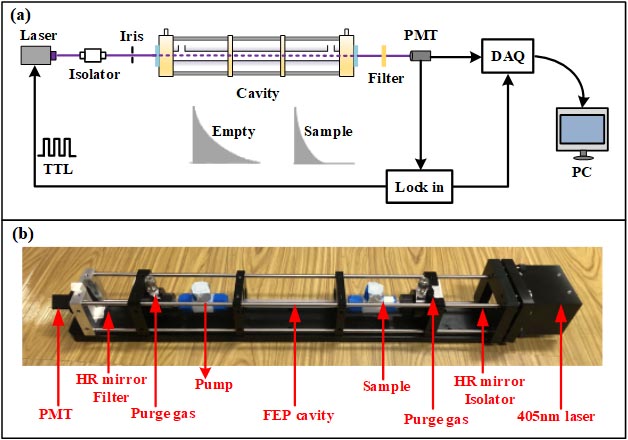
A novel detection technology, developed by a research team led by Prof. ZHANG Weijun from Hefei Institutes of Physical Science (HFIPS), Chinese Academy of Sciences (CAS) recently, realized fast and sensitive detection of nitrogen dioxide (NO2).
The relevant result was published in Analytical Chemistry.
NO2 is one of the most important pollutants in troposphere and plays an extremely important role in the process of atmospheric pollution. Thus, highly sensitive and accurate measurements of NO2 are of great significance to atmospheric chemistry research and air pollution prevention and control.
In this research, scientists applied amplitude modulation technique to a multimode diode laser for the first time, and developed an Amplitude Modulated multimode-diode-laser-based Cavity Enhanced Absorption Spectroscopy (AM-CEAS) system for extremely sensitive NO2 detection. The new instrument TTL-modulated at 35 kHz was operated at 406 nm, using phase-sensitive detection for ultra-sensitive absorption measurement. The detection precisions of the instrument were 35 pptv and 8 pptv, respectively, in 1 s and 30 s data acquisition time, over 4 times lower than what was achieved with Cavity Ring-Down Spectroscopy (CRDS) method using the same instrument.
Combining with ring-down time measurement, the AM-CEAS method can eliminate the calibration process of mirror reflectivity, thus realizing NO2 absolute concentration measurements. It also has the advantages of high injection efficiency like on-axis alignment CRDS, low cavity-mode noise like off-axis alignment CEAS and phase-sensitive detection of modulation spectroscopy. The AM-CEAS instrument is a simple, reliable, low-cost, self-calibration tool suitable for long-term stability and low maintenance needs, which has a promising prospect in the scientific research and operational application.
At present, the newly developed instrument is participating in the comprehensive field observation at an urban site of Beijing, and is used for measuring the atmospheric total reactive nitrogen during the Beijing 2022 Olympic Winter Games.
This research was supported by the National Natural Science Foundation of China, the Second Tibetan Plateau Scientific Expedition and Research program, the Youth Innovation Promotion Association CAS, the Instrument Developing Project of the Chinese Academy of Sciences, and the HFIPS Director’s Fund.

Figure 1. Schematic diagram of the experimental setup of the AM-CEAS instrument. (Image by ZHOU Jiacheng)

Figure 2. Performance evaluation of the AM-CEAS method and comparison with CRDS measurements. (Image by ZHOU Jiacheng)